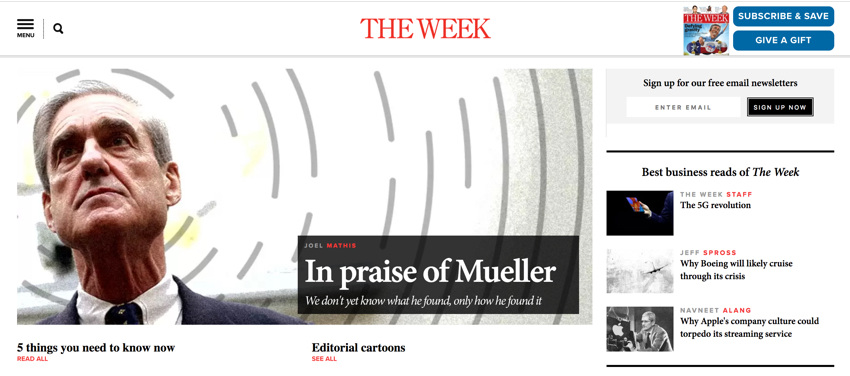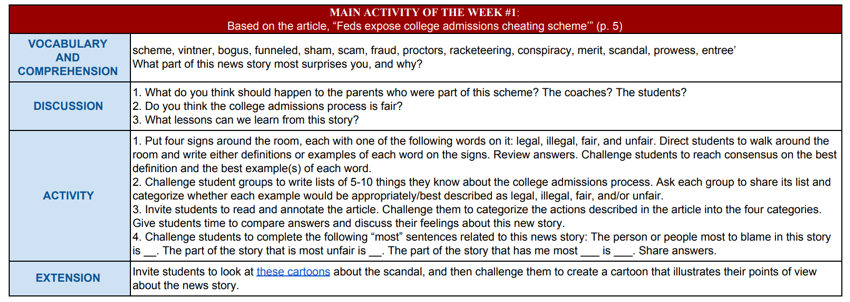The Week. It’s the 2019 version of our favorite Weekly Reader that your kids need
Students access articles, editorials, and resources covering a variety of topics on a regular basis.

I spent the majority of my grade school years at Alta Brown Elementary School in Garden City, America, working on my three Rs. It was pretty traditional stuff – snacks every afternoon, keeping the metal slipper slide super slick with our waxed milk cartons, lots of math drills, straight rows of desks, and, of course, the very awesome Weekly Reader that showed up every Thursday.
Surely you haven’t forgotten the Weekly Reader.
For those of you who didn’t have that particular grade school experience, the Weekly Reader showed up, well . . . every week. Designed for elementary kids, it highlighted current events and always included interesting feature stories. And it was glorious. At least for a budding social studies nerd like me.
My memories were jogged a week or so ago when I ran across the 2019 Weekly Reader equivalent. The Week is a current events magazine with a program designed for your middle and high school kids. It’s a great way for you and your kids to get in-depth coverage of contemporary issues and feature stories in the arts, science, politics, life styles, and books. I’ve talked before about how important it is for us to connect the past with current issues. Our kids need to see and make those connections.
Using a variety of resources to focus on current events can help you do that. The problem, of course, is finding useful and trustworthy sources. The Week has been doing this sort of thing for years in both print and digital versions with the goal of providing clear and concise news and commentary. And while we know that bias doesn’t mean inaccurate, it’s nice to know that one of my favorite fact checker sites, AllSides, rates The Week as having a media bias rating of “Center.” Amazon reviewers also give it high marks.

They’ve developed a Classroom Education Program that has some helpful tools designed to support you as you connect historical events and contemporary issues. The idea is basically the same as my Alta Brown elementary experience – kids access articles, editorials, and resources covering a variety of topics on a regular basis. You guide their reading, conversation, and responses to the content.
Your classroom subscriptions can be print, digital, or a combination of both. The digital version is mobile-friendly so if your kids are on tablets or their phones, access is still full featured. If you’re teaching any type of current events class, this is obviously something that fits snugly into what you are already doing. But government, US history, and world history teachers would benefit as well from access to this type of moderated news source.
Tools and ideas to transform education. Sign up below.

Along with the print and digital version for your kids, teachers also get a weekly Lesson Guide. Each Guide includes a variety of scaffolding questions and teaching activities. You get different suggestions for activities and links to supporting websites. Browsing through the different Guides, there seems to be some nice links to ELA skills. So working together with your English department folks makes some sense here.


There’s also a handy Teacher Reference Guide that outlines how teachers can use The Week in their classrooms. The Reference Guide says that the magazine is structured so that it reads like a presidential briefing, based on stories and editorials from different American and international media. I like that idea of a briefing memo – just enough information so that I have what I need to make decisions. Perfect for writing prompts, small or whole class discussions, or as evidence to support argumentative products.
The Reference Guide is designed to give you a bit of how each issue comes together along with a couple of pages of instructional suggestions. I especially like the idea of using articles and commentary from The Week to jumpstart conversations around different Constitutional amendments. So if you do decide to use The Week, this is where you need to start.
I do try to focus on free stuff when sharing things with teachers but The Week looked good enough to recommend – even if it does require a subscription. One of the reasons that I learned about The Week’sed version is that they’ve got a deal going with some pretty decent school pricing – including access to both print and digital editions along with a free subscription for you. Get more info on that deal here.
We can’t go back to the ’70s and ’80s and the Weekly Readers that some of us grew up on. But we remember Weekly Readers because they were fun to use and they were good for us. And just because it’s 2019 doesn’t mean we shouldn’t be finding ways for students to experience the same thing. The Week can help.
cross posted at glennwiebe.org
Glenn Wiebe is an education and technology consultant with 15 years' experience teaching history and social studies. He is a curriculum consultant forESSDACK, an educational service center in Hutchinson, Kansas, blogs frequently at History Tech and maintains Social Studies Central, a repository of resources targeted at K-12 educators. Visit glennwiebe.org to learn more about his speaking and presentation on education technology, innovative instruction and social studies.
